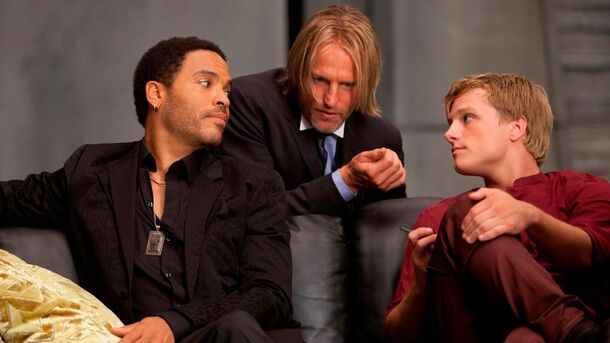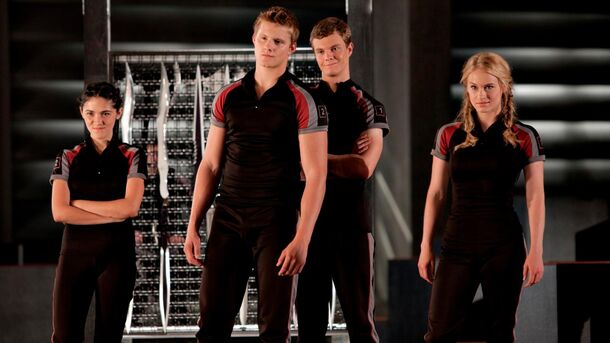The Hunger Games: 6 Historical Connections You Totally Missed

So can we say that The Hunger Games franchise is based on (almost) true events..?
Not everyone knows it, but The Hunger Games franchise, both in Suzanne Collins' literary realm and its cinematic adaptation goes far beyond a simple dystopian narrative. The series delicately weaves historical parallels from antiquity to the modern era that might slip through the cracks to the casual observer.
From universal themes to compelling characters and subtle historical nods, here are 6 historical connections in The Hunger Games series that you may never have noticed.
1. The Three-Finger Salute
The three-finger salute has a rich history of rebellion and echoes real-world movements, as inspired by Tommie Smith and John Carlos' 1968 Olympic protest, the gesture symbolizes a stand for human rights.
In The Hunger Games, it symbolizes resistance to the Capitol's tyrannical rule, and when Katniss encounters the salute, it becomes a poignant expression of gratitude, admiration, and farewell. This fictional symbol has also jumped into reality, sparking protests around the world in places like Thailand, Hong Kong, and Myanmar.

2. Panem
In The Hunger Games franchise, the dystopian nation of Panem, created after global catastrophes, draws parallels to Imperial Rome with its Latin-inspired name. Panem et Circenses, meaning "bread and circuses," reflects the tactic of using food and entertainment to pacify and control the masses. Author Suzanne Collins explores this theme by depicting how the provision of bread and circuses manipulates people into surrendering political power.
Much like Rome's distraction with free wheat and entertainment, the Capitol controls the districts of Panem with essential resources and the spectacle of the Hunger Games. This concept is carried further in Peeta Mellark's name, which sounds like "pita," connecting him to his family's bakery and adding symbolic depth to the narrative.
.jpg)
3. The Names
The series weaves Greek mythology and ancient Rome into its narrative, introducing myth-inspired characters such as Castor and Pollux, the twin brothers of Helen of Troy. Effie Trinket's name is also a nod to both a Greek nymph and a Christian martyr, while Cinna is linked to figures from the era of Julius Caesar.
Seneca Crane pays homage to the Stoic philosopher, and Plutarch Heavensbee is inspired by the Greek historian Plutarch and Coriolanus Snow is named after the Roman figure Caius Marcius Coriolanus, who, like his on-screen counterpart, was opposed to the rule of the people.

4. Reaping
It turns out that Susan Collins, a self-proclaimed Greek mythology nerd, has acknowledged the influence of these myths on her storytelling. A clear homage is seen in the parallel with the myth of Theseus and the Minotaur — in this Greek myth, young people are sacrificed to the Minotaur at the request of King Minos of Crete, mirroring the reaping ceremony in The Hunger Games, where two tributes are chosen from each district.
Katniss Everdeen's voluntary participation in the reaping echoes Theseus' courageous confrontation of the Minotaur to end the cycle. This clever weaving of ancient Greek myth into a futuristic dystopian narrative adds depth and enduring themes of sacrifice and resistance to Collins' acclaimed series.
.jpg)
5. Career Tributes
Tributes from Districts 1, 2, and 4 are known as Career Tributes for their specialized training for the Games, much like the professional gladiators of ancient Rome. Like the Roman gladiators who underwent rigorous training for public entertainment, Career Tributes represent a historical phenomenon in which individuals are groomed for a deadly spectacle.
In ancient Rome, gladiatorial schools like the Ludus Magnus were privately owned, and patrons could gain social prestige and make lucrative bets by backing a trained gladiator. Just as the Romans supported gladiators for social prestige and wagers, the wealthy residents of Panem support tributes for similar reasons, creating fascinating parallels between the two worlds.

6. The Districts
Hunger Games, in which each district contributes specific goods to the Capitol, mirrors the historical model of the Roman provinces that supported the Empire. The distribution of resources in the districts follows Roman practice, with different regions providing essential materials to sustain the empire.
This intricate system ensured a symbiotic relationship, much like the historical use of resources to support military and administrative functions in the Roman Empire.